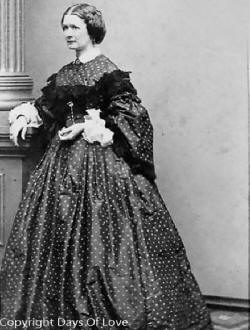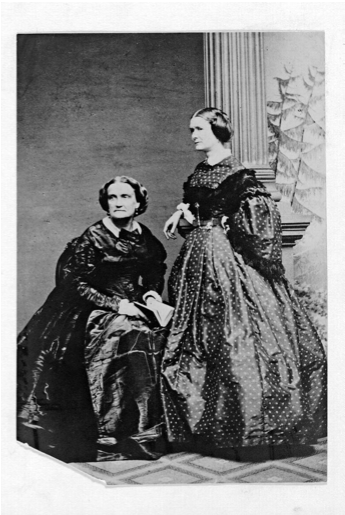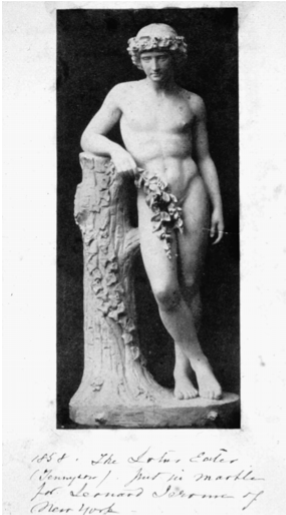

Partner Charlotte Saunders Cushman
Queer Places:
Bethesda Fountain, Terrace Dr, New York, NY 10024, Stati Uniti
Via Gregoriana, 38, 00187 Roma RM
Via di S. Basilio, 45, 00187 Roma RM
49 Catherine St, Newport, RI 02840
Green-Wood Cemetery, 500 25th St, Brooklyn, NY 11232, Stati Uniti
 Emma
Stebbins (1 September 1815 – 25 October 1882) was an American sculptor. She is
best known for her work “The Angel of the Waters” (1873), also known as
“Bethesda Fountain,” located on the Bethesda Terrace in Central Park, New
York.[1][2]
Until her death in 1876, Charlotte Cushman
cultivated a public persona as a respectable artist and lived openly with Emma
Stebbins in an elegant apartment brimming with friends and pets.
Emma
Stebbins (1 September 1815 – 25 October 1882) was an American sculptor. She is
best known for her work “The Angel of the Waters” (1873), also known as
“Bethesda Fountain,” located on the Bethesda Terrace in Central Park, New
York.[1][2]
Until her death in 1876, Charlotte Cushman
cultivated a public persona as a respectable artist and lived openly with Emma
Stebbins in an elegant apartment brimming with friends and pets.
The community of talented women in Rome included artists whose lives and works have become well known in art-historical circles: Harriet Hosmer, Edmonia Lewis, Anne Whitney, and Vinnie Ream; and those whose reputations have remained (until now) buried in the historical record: Emma Stebbins, Margaret Foley, Sarah Fisher Ames, and Louisa Lander. In 1903, Henry James immortalized this community of American women sculptors in Rome by characterizing them as “that strange sisterhood of American lady sculptors who at one time settled upon the seven hills [of Rome] in a white marmorean flock.” Hosmer, Lander, Stebbins, and Foley, under the mentorship of the thespian Charlotte Cushman, formed a close-knit and supportive community (though not without personal and professional jealousies) that the author Nathaniel Hawthorne rendered with some sympathy in his romantic account of American artists in Rome, The Marble Faun (1860).
Stebbins was born in New York City to a wealthy family who encouraged by her pursuit of art from an early age. She studied with the portrait painter Henry Inman and between 1839 and 1841 worked under the tutelage of the sculptor Edward Brackett before he moved to Boston. By the early 1840s, she had become an active participant in the New York art world, had joined the American Art Union, and had been admitted as an associate member to the National Academy of Design, where she exhibited portrait drawings in 1843 and 1844. She also exhibited at the Pennsylvania Academy of the Fine Arts in 1845 and again in 1847. After traveling to Rome with her sister and mother in 1856, she decided within six months to settle permanently in the city. In 1857, her brother Col. Henry G. Stebbins (head of the New York Stock Exchange) sponsored her to move to Rome, where she moved in with sculptor Harriet Hosmer, who had established herself there in 1852. She studied under John Gibson an English neoclassicist working there at that time.

Cushman and Stebbins

Emma Stebbins, The Lotus Eater, 1857–60, now lost. Photograph, Emma
Stebbins Scrapbook, 1858–82, Archives of American Art, Smithsonian
Institution, Washington, D.C.
Angel of the Waters, Central Park, New York City, NY
In Rome, she was able to become involved in the bohemian and feminist lesbian lifestyle, which was far less acceptable in New York.[3] Stebbins fell in love with actress Charlotte Cushman. Cushman was confident, strong, and charismatic, and recently recovering from a break up following a ten-year relationship with the actress Matilda Hays.
“Modest and gentle” by reputation, Emma Stebbins was in 1856 the newest member to join Rome’s women’s community. Harriet Hosmer took Stebbins under her wing, escorting her to famous sites and introducing her to members of the artistic community; the two rode their horses together on the Campagna. Hosmer curiously described Stebbins as her “wife” and as a scultrice (woman sculptor), perhaps using these feminine appellations to allude to Stebbins’s passive and dependent nature.
Under the direction of Paul Akers, she created The Lotus Eater (Ganymede), a small-scale male nude, between 1857 and 1860. She was the first American woman artist to undertake the male nude in sculpture, modeling her thirty-inch-high marble statuette for a private patron. In 1861, Stebbins exhibited her sculpture in New York and Boston, at the moment that Nathaniel Hawthorne’s novel, The Marble Faun, achieved international acclaim. Hawthorne admired Stebbins’s sculpture and sent her a greeting in which he encouraged her to create other works “as beautiful (if possible) as the Lotus Eater.”
Charlotte Cushman and Emma Stebbins built a life together in Rome, using the trope of domesticity to emulate the heterosexual nuclear family. In March of 1857, they traveled to Naples, a sojourn that cemented their romantic attachment. At the time, Cushman was still involved with Matilda Hays. In April, Hays fled Rome after an emotional confrontation with Cushman. By July, Stebbins and Cushman had formalized what would become a lifelong partnership. “The current of [our] two lives ran, with rare exceptions, side by side,” Stebbins would later write. “We were in Rome, as ‘travellers and pilgrims’ to the famous city.” Although theirs was not an untroubled relationship, they exchanged vows of love and fidelity in 1859. Cushman described their relationship as a marriage: “Do you not know,” she wrote to Wayman Crow, “that I am already married and wear the badge upon the finger of my left hand?”
Hosmer had once called Stebbins "wife". But it was with Cushman that Stebbins shared rooms when they moved to Via Gregoriana, 38, in November, 1858. Hosmer became "single", living separately at the same address for several years. But soon Cushman and the headstrong Hosmer were at odds. Hosmer moved accross the Piazza Barberini and next door to artist William Wetmore Story. Eventually their resentments faded, but they never regained their closeness.
Charlotte Cushman held her first reception in her new home in January of 1859, beginning a tradition that would continue for many years. Mingling at this festive event were the feminist art historian Anna Jameson, Fanny Kemble, Adelaide Sartoris, and the British author and reformer Mary Howitt, to name just a few. When the Irish feminist Frances Power Cobbe came to town, she noted: There was a brightness, freedom and joyousness among these gifted Americans, which was quite delightful to me. Cushman had the gift of drawing out the best from all who came, explained Emma Crow, the youngest daughter of the philanthropist Wayman Crow.
Cushman and Stebbins began traveling together, immediately taking a trip to Naples. Upon their return, they began spending time in a circle that included African American/Native American sculptor Edmonia Lewis and other lesbians, such as Harriet Hosmer.[3]
In the 1860s, the Englishman Henry Wreford promoted a movement of women artists in Rome known as the 12 Star Constellation amongst whom were Charlotte Cushman, Margaret Foley, Harriet Hosmer, Edmonia Lewis, Emma Stebbins. Henry Wreford was a figure of curiosity for historians and literary experts of the time but remained relatively unknown to the wider public despite his substantial role within the political world of pre-unified Italy and his promotion of the culture of gender.
In 1866 Henry Wreford, a freelance correspondent in Italy, described the female artists in Rome collectively as “a fair constellation . . . of twelve stars of greater or lesser magnitude, who shed their soft and humanising influence on a profession which has done so much for the refinement and civilization of man.” Some of Wreford’s twelve stars, incidentally all American sculptors, are still recognizable names even today: Margaret Foley, Florence Freeman, Harriet Hosmer, Edmonia Lewis, and Emma Stebbins. Less known now are the American painter sisters Mary Elizabeth Williams and Abigail Osgood Williams, the Italian sculptor Horatia Augusta Latilla Freeman and her relative, the painter Adah Caroline Latilla, Irish painter and sculptor Jane Morgan, and English sculptor Isabel Cholmelay (her studio was at Palazzetto Sciarra). It is not entirely clear which of these women produced art of “greater magnitude” in Wreford’s mind; his discussion is rather general overall. Indeed, in his article and in others of the period, even the better-known women tend to earn more comments about their personalities, appearances, or behaviors than about their art.
Henry T. Tuckerman, an American writer who lived in Italy, included a brief section on American female sculptors in Rome in his Book of the Artists (1867). In less than five pages, in a volume of more than 600 pages total, he discussed several members of Henry Wreford’s constellation, including Margaret Foley, Florence Freeman,[9] Harriet Hosmer, Edmonia Lewis, and Emma Stebbins. He briefly mentioned Sarah Fisher Clampitt Ames, Louisa Lander, Vinnie Ream, and Anne Whitney, though by that date Lander and Ames had returned to the United States and Ream had not yet arrived in Rome. Tuckerman’s description was hardly complementary; he noted that public appreciation of their art seemed to derive from “national deference to and sympathy with the sex” and from a lack of understanding about art in general. Yet even his dismissive analysis shows awareness of and interest in these women and their activities.
In 1869, Cushman was treated for breast cancer. Stebbins devoted all her time to nursing Cushman, ignoring her work during the next two years. The following year, the couple returned to the United States. Cushman died of pneumonia in 1876 at the age of 59. Following the death of Cushman, Stebbins never produced another sculpture. She spent her final years producing the correspondence, Charlotte Cushman: Her Letters and Memories of Her Life in 1878. Stebbins died in New York in 1882, at the age of 67.[3]
One of Stebbins' early commissions was a portrait bust of Cushman between 1859-1860.
Her bronze statue of educator Horace Mann was installed outside the State House in Boston in 1865.
Stebbins' best known work is the Angel of the Waters (1873), also known as Bethesda Fountain, located on the Bethesda Terrace in Central Park, New York. According to Central Park historian Sara Cedar Miller, Stebbins received the commission for the sculpture as a result of influence from her brother Henry, who at the time was president of the Central Park Board of Commissioners. Henry was proud of his sister's talent and hoped to have many examples of her art in Central Park. Angel of the Waters was created to celebrate the clean healthful water from New York's Croton Aqueduct, completed in 1842, with an oblique reference to the biblical "healing waters of Bethesda". The fountain complex is widely considered to be one of the great works of nineteenth-century American sculpture.
Most of what is known of Stebbins is due to the efforts of her older sister Mary Stebbins Garland, who documented her sister's life posthumously in a biography and a scrapbook. The unpublished biography is entitled "Notes on the Art Life of Emma Stebbins" (1888). In the scrapbook, Garland arranged images of Stebbins' works created between 1857 and 1870 in chronological order, noting the titles and dates of execution of each work. She included photographs of Stebbins and of people who had encouraged her career (such as her teacher Paul Akers, Henry Stebbins, and Charlotte Cushman), newspaper clippings and handwritten biographical notes.[2]
After Cushman’s death in 1876, Emma Stebbins wrote a biography of her former spouse that made only one direct statement about their relationship: “It was in the winter of 1856– 57 that the compiler of these memoirs first made Miss Cushman’s acquaintance, and from that time the current of their two lives ran, with rare exceptions, side by side.” But Stebbins attested to her marital connection with Cushman through the very act of writing the biography as a memoir, in her pointed exclusion of Cushman’s other lovers from her account, in her detailed description of their shared apartment in Rome, and in a ten-page inventory of their pets, including dogs named Teddy and Bushie. One of the women’s many pets became the subject of a eulogy by Isa Blagden, a writer who lived in Florence and was close to Stebbins and Cushman, for whom she composed “To Dear Old Bushie. From One Who Loved Her,” cited in full in Stebbins’s biography. In its emphasis on the true devotion of a passionate love that remains tacit, the poem signals Blagden’s genuine affection for Bushie and her appreciation for the “lifelong love” between the two women with whom the dog lived.
Emma Stebbins, her brother Henry and other family members are buried at Green-Wood Cemetery, in Brooklyn, New York.
On June 14, 2014, Stebbins was featured in the first gay-themed tour of Green-Wood Cemetery. Because the headstone of Miss Stebbins is made of marble it has become severely worn away by the weather, making it difficult to read her name, dates, etc., Walk About New York, developer of the Gay Graves Tour, would like to start a campaign to replace it.[4][5]
My published books: